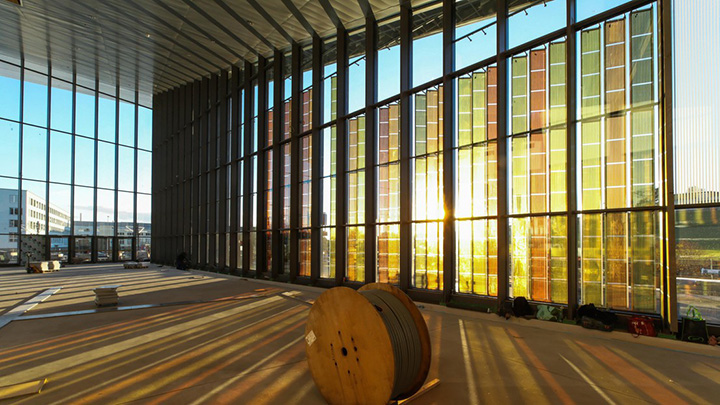Electricity-Generating Windows: Scientists Design More Efficient Transparent Solar Panels
November 7, 2022
Scientists in Switzerland have reached a new efficiency record for dye-sensitized solar cells, paving the way for electricity-generating windows that could help power our homes.

Grätzel cells installed at the SwissTech Convention Center / Credit: Alain Herzog
A dye-sensitized solar cell (DSC), also known as the Grätzel cell, is a low-cost solar cell based on a semiconductor formed between a photo-sensitized anode and an electrolyte. It was invented in 1988 by Brian O'Regan and Michael Grätzel.
The design aims to generate electric power by moving electrons from the photosensitizer towards an electrical output like a device or a storage unit.
DSCs are transparent, can be fabricated in multiple colors for low cost, and are already being used in skylights, greenhouses, as well as glass facades. In addition, lightweight flexible versions of DSCs are now commercially sold on a large scale for electrical powering of portable electronic devices.
Now, scientists at the Swiss Federal Institute of Technology Lausanne (EPFL) have developed a way of improving the packing of two newly designed photosensitizer dye molecules to enhance the DSC's photovoltaic performance.
The team was able to increase the power conversion efficiency of DSCs beyond 15% in direct sunlight and 30% in ambient light conditions.
"Our findings pave the way for facile access to high-performance DSCs and offer promising prospects for applications as power supply and battery replacement for low-power electronic devices that use ambient light as their energy source," wrote the authors of the study, published in the scientific journal Nature.
Click Here For The Most Popular On Sunny Skyz
 Boy With Down Syndrome Nails The Whitney Houston Challenge, And The Crowd Goes Wild
Boy With Down Syndrome Nails The Whitney Houston Challenge, And The Crowd Goes Wild
 Lowe’s Staff Refuse To Give Up On Missing Cat, Find Her 85 Miles Away
Lowe’s Staff Refuse To Give Up On Missing Cat, Find Her 85 Miles Away
 People Are Sharing The Funniest Company Fails After This Health Insurance Letter Went Viral
People Are Sharing The Funniest Company Fails After This Health Insurance Letter Went Viral
 ‘Heavily Intoxicated’ Raccoon Passes Out In Liquor Store Bathroom After Breaking In
‘Heavily Intoxicated’ Raccoon Passes Out In Liquor Store Bathroom After Breaking In
 Cat With A Gat: Owner 3D Prints Toy Glock, Hours Later Walks In On This
Cat With A Gat: Owner 3D Prints Toy Glock, Hours Later Walks In On This
 The ‘Grandma Stand’ Is Bringing Comfort And Connection, One Conversation At A Time
The ‘Grandma Stand’ Is Bringing Comfort And Connection, One Conversation At A Time
 Boy With Down Syndrome Nails The Whitney Houston Challenge, And The Crowd Goes Wild
Boy With Down Syndrome Nails The Whitney Houston Challenge, And The Crowd Goes Wild
 Stranded Mom Faces A Terrifying Breakdown, Then A Father-Son Duo Steps In To Save The Day
Stranded Mom Faces A Terrifying Breakdown, Then A Father-Son Duo Steps In To Save The Day
 A Struggling Mom Could Not Stop Crying After A Stranger’s Christmas Gift
A Struggling Mom Could Not Stop Crying After A Stranger’s Christmas Gift
 'That Looks Like Me': Boy Surprises Aunt With Portrait At Art Show
'That Looks Like Me': Boy Surprises Aunt With Portrait At Art Show
 We Can’t Stop Laughing At These Doodles Playing 'Tug of Peace'
We Can’t Stop Laughing At These Doodles Playing 'Tug of Peace'
